
Volume 55 - Spring 2023
Replacing Components of a Book
Spine Leather by Karen Vidler
In this article, Book and Paper Conservator, Karen Vidler (FIIC) discusses an often-debated topic in the conservation of cultural heritage, replacing components. She reflects on a conservation project completed in 2022 where she had to consider replacing the spine of a 17th Century rare book.
Often book conservators are asked to consider the replacement of the components of books such as the leather bindings in the image below (fig.1). This is a problematic treatment as conservators are expected to retain as much of the original structure and materials of a bookbinding as possible. This being an underpinning principle of ethical conservation practice which steps away from more traditional restoration practices. We do this in order to hold the value of the book as both a cultural artifact and within the marketplace. At BCS we have been developing and refining techniques to retain the original spine leather such as improved examination techniques, safer ways to reattach boards and investigating hydrophobic leather treatments before performing repairs.

fig.1 - Long Room collection, Trinity College Dublin, UK (Image Wikipedia)
But situations still arise where we are asked to conserve books that have spine leather which is too degraded to respond to current treatments. A damage map and fibre cohesion test can offer some information on how advanced the acid decay or other damage is which cannot be treated to halt this change. This is common when the spine leather has been exposed to damaging levels of environmental factors such as UV light, water, heat, polluting gasses, an overzealous application of leather dressing. This damage is made worse in combination with mechanical damage from opening the book, which is the intended function of a book - can this read which is the intended function of the binding.
In the bindery this year we were asked to treat a book which is an example of this advanced deterioration to the spine leather. The book was an early edition of Nicholas Culpepers Pharmacopoeia Londinensis; or, The London Dispensatory. London: George Sawbridge, 1675. As can be seen from the image below (fig.2) the spine area was a good example of a problematic covering leather. Mapping the damage by tracing the losses and weakness onto a Mylar® sheet and performing a fibre cohesion test revealed there was no viable area of leather on the spine.
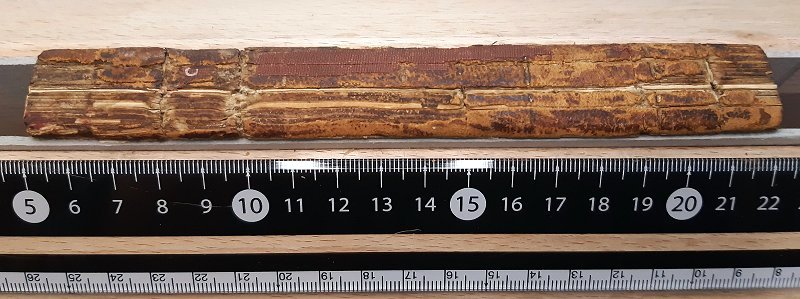
fig.2 - Before: Damage to spine leather
Also, the spine leather is a strengthening and protective covering for the sewing beneath. In this case the recessed sewing supports were split in several places and the sewing broken. Added to this was the staining to around 90% of the text leaves, an example of which can be seen in the image below (fig.3). As this book was expected to be consulted by academic researches, we discussed the treatment options with the collection care staff before deciding the final conservation treatment plan. The book needed to be safely read within a reading room setting or placed on display, so using materials and techniques with long term stability were required for this treatment.
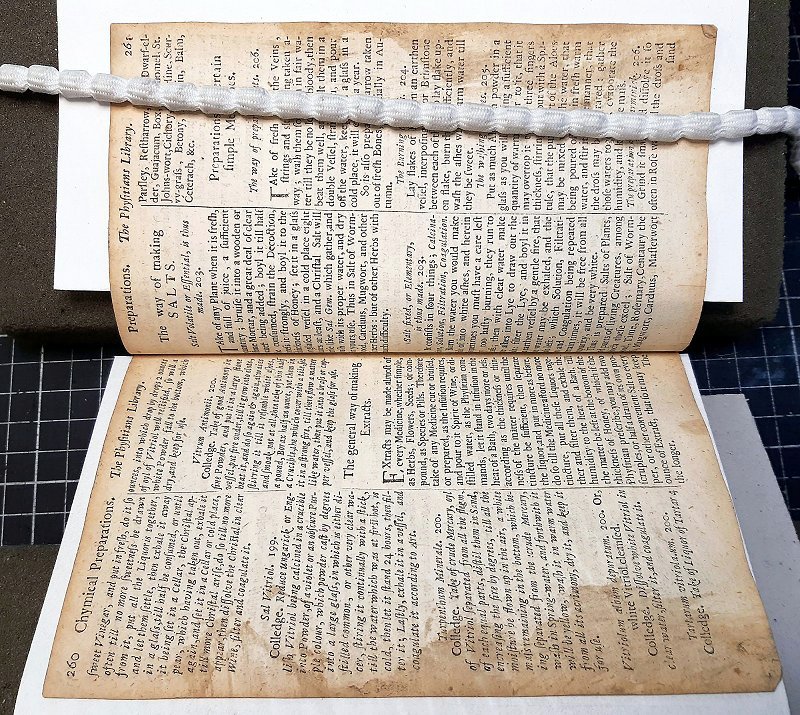
fig.3 - Before: Typical staining within the bookblock
The decision to replace the spine leather takes into consideration other areas of damage to the book. The sewing was no longer consolidating the bookblock into a single unit and most of the leaves were disfigured by staining. If the spine leather was to be replaced, the conservator would be expected to use archival quality leather that was dyed to a suitable colour and in keeping with the available evidence of the original tooling. There was fragmentary evidence of a spine label and blind tooling in imitation of raised band panels.
We began the treatment with collation checking, mechanical cleaning then immersion washing to reduce the staining and other acidic components in the paper text leaves (fig.4). Only the most weakened leaves were resized to improve paper strength for future handling or to provide a stronger substrate for fine tears and infill paper repairs.
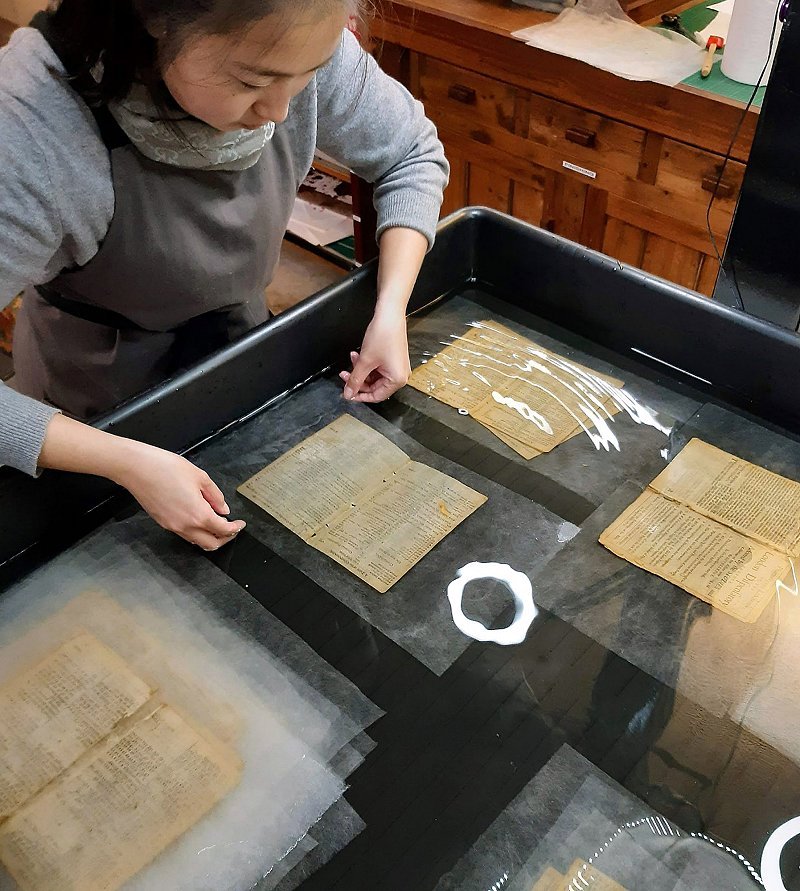
fig.4 - During: Yuhong Zhang immersion washing sections in small batches
Working from the initial examination and diagram of the sewing, we returned the book to the original recessed cord sewing style (fig.5). We were mindful of any evidence within the backfolds of each section of previous sewing, but there was none. After guarding the damaged backfolds with kozo fibre Japanese repair paper the bookblock was resewn on 4 recessed linen cords using a sewing frame to keep the cords under tension during sewing.
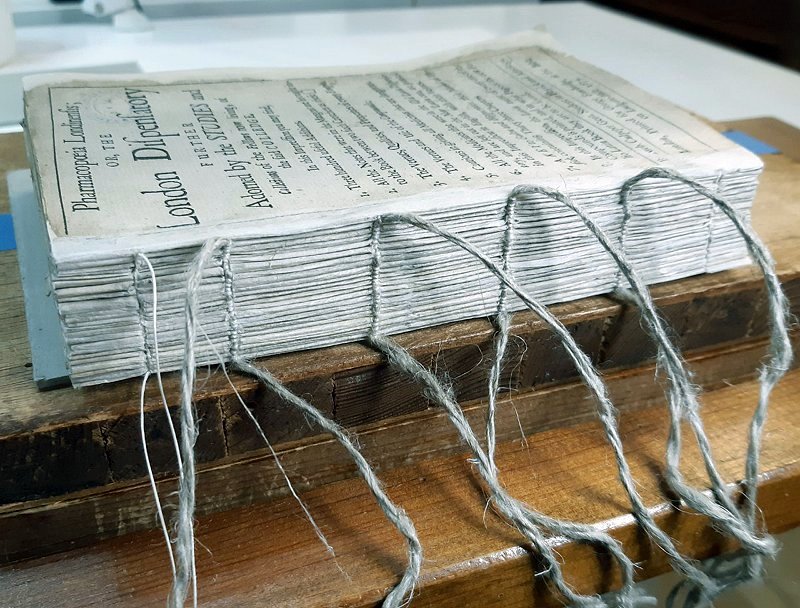
fig.5 - During: Bookblock resewn on recessed linen cord supports
During the examination, evidence of two-colour, worked endbands were found within the gutters of some of the sections. These fragments and staining of the tie-downs being strong evidence of the presence of endbands. These were replaced on the bookblock using a made-off-the-book endband in similar colours to the original (fig.6). We chose the made-off-the-book method as we did not want to add further strain to the original folds of this older paper dating from 1675.
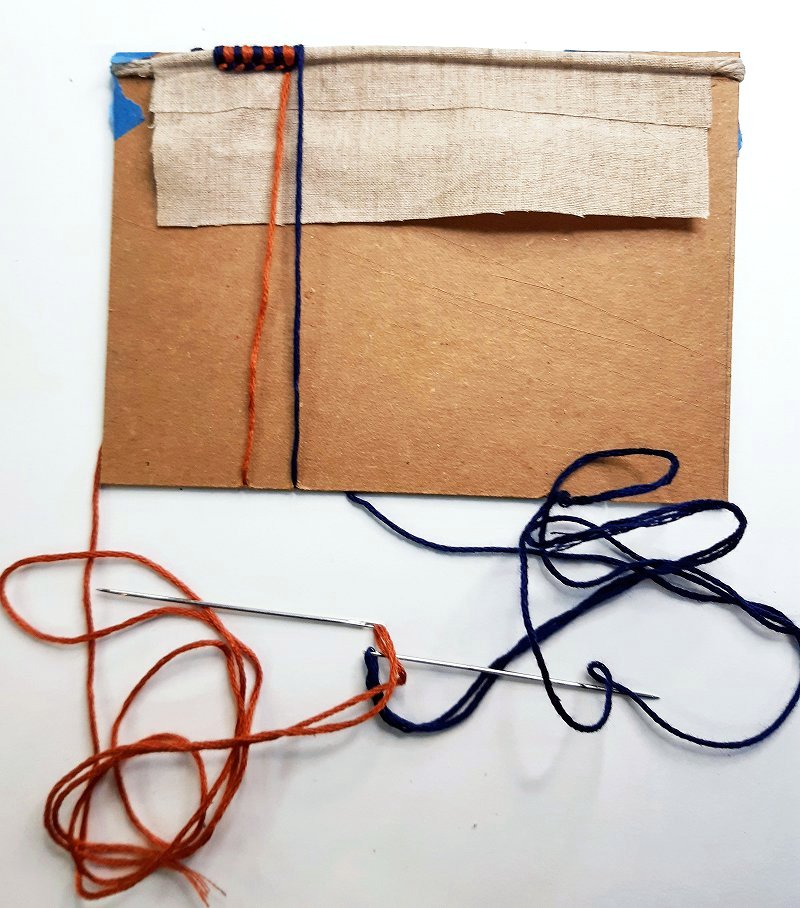
fig.6 - During: New endbands worked in two cotton threads through resized aero linen
Both boards were detached, so were reattached following the original board attachment style. This meant that only the first and last lacing slips were used as the remaining had been trimmed flush with the bookblock to save time in this part of the original forwarding process (fig.7). To use all 4 new lacing slips would be over-repair and not in keeping with the original binding.
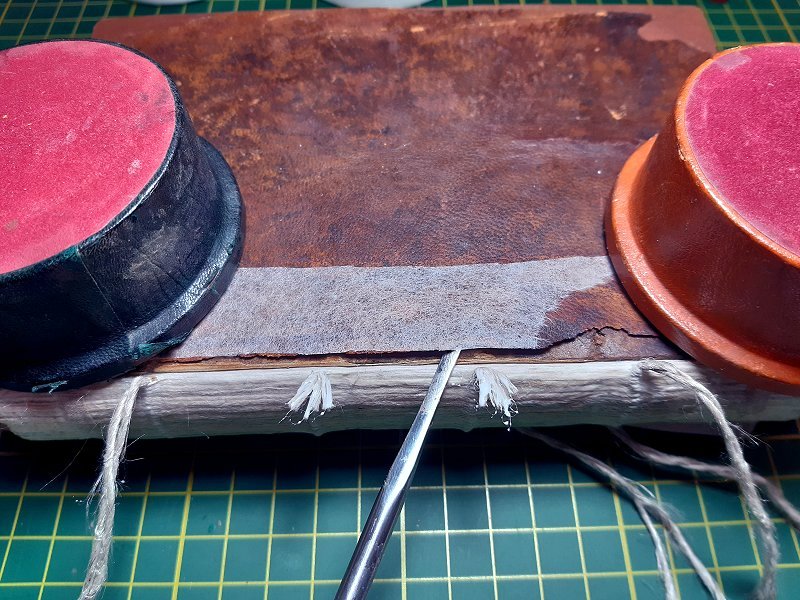
fig. 7 - During: Reattaching the boards using original lacing style
The spine leather chosen for this book was a J. Hewit & Sons undyed calf skin, dyed by the conservator with water-based, Roda dyes to suit the leather on the boards. At BCS we prefer not to use a fixative, but instead leave the dyed leather to dry for at least 7 days to be fully dry, and only slightly damp the leather before attaching to the book. We also prefer to not pare the leather below 0.7mm to ensure we do not reduce the strong corium layer within the leather. The fragmentary evidence of the original tooling design was used in the final spine design of a red goat skin leather label and blind tooled lines in imitation of a raised band design (fig.8).
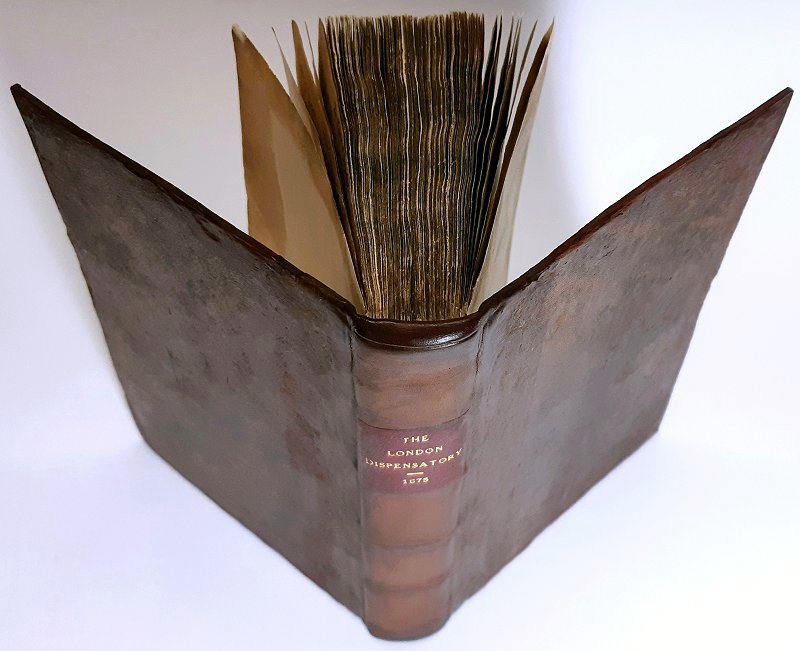
fig.8 - After: The completed book
The decision to replace the spine leather of any book must be done after gathering evidence and consideration for future care and handling. For this 1675 edition of Culpepers London dispensatory, we examined all components of the book and materials using non-destructive or micro-sample methods. Only with evidence can any conservator formulate a carefully considered remedial conservation treatment plan. Any conservation treatment carries a burden of responsibility for both the conservator and the custodian of the book, so must be discussed and agreed before the treatment begins.
Acknowledgement: Karen would like to thank 2022 intern Yuhong Zhang for her assistance with the conservation treatment to Nicholas Culpepers Pharmacopoeia Londinensis; or, The London dispensatory, 1675. Collaboration in conservation keeps us questioning and improving our treatments.
You can follow the teaching and practical conservation work undertake by staff and interns at Book Conservation Services by following their Facebook and Instagram pages or subscribe to The Bindery newsletter by emailing bcsbindery@gmail.com.
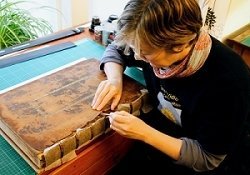 Karen Vidler FIIC - is a qualified bookbinder and book conservator, who trained at both Guildford College and West Dean College, UK. She has managed the small private conservation practice, Book Conservation Services, since 2006. Prior to establishing this business she worked at The National Archives, Kew, London, the V&A Museum and The Leather Conservation, Northampton, UK. She has been a visiting tutor at West Dean College and delivered training in the conservation of leather bindings in the UK, Europe, Australia and East Asia. She pursues ongoing research into an improved understanding of bookbinding leather and its specific conservation needs. She is a contributing author to the Conservation of Book published by Routledge in 2023.
Karen Vidler FIIC - is a qualified bookbinder and book conservator, who trained at both Guildford College and West Dean College, UK. She has managed the small private conservation practice, Book Conservation Services, since 2006. Prior to establishing this business she worked at The National Archives, Kew, London, the V&A Museum and The Leather Conservation, Northampton, UK. She has been a visiting tutor at West Dean College and delivered training in the conservation of leather bindings in the UK, Europe, Australia and East Asia. She pursues ongoing research into an improved understanding of bookbinding leather and its specific conservation needs. She is a contributing author to the Conservation of Book published by Routledge in 2023.
